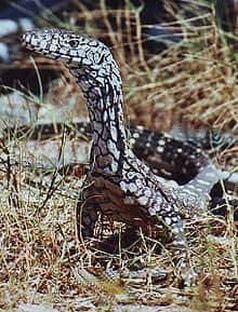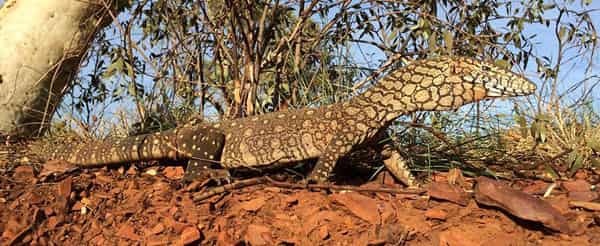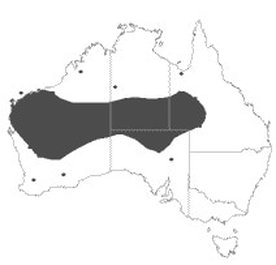PerentieVaranus giganteus |

Custom Search
|
The perentie inhabits the arid regions west of the Great Dividing Range from coastal Western Australia to Western Queensland and is usually found in rocky hills and outcrops, semi-arid savannas and caves.
They also dig very extensive and complex burrows in the sand using their powerful front legs and claws. Typically these burrows have more than one escape exit and provide protection against extreme weather conditions and predators. Because of the remoteness of much of their range and their usual shyness they are not a common sight. Perenties may very well grow up to more than 8 ft (2.5 m) in length, nonetheless, their common length is mostly about 6 to 7 ft (1.75 to 2 m). They can weigh up to 33 lb (15 kg) but their maximum weight could very well be over 44 lb (20 kg ). The crocodile monitor, their adversary for the position of the 3rd largest lizard in the world is in fact usually a bit longer, reaching in excess of 7.8 ft (2.4m) in length, but isn't as heavy not to mention it's substantially less bulky when compared to the perentie. But nonetheless, perenties are actually quite slender lizards and are significantly less bulky than their biggest relatives the Komodo dragon or even the Asian water monitor. Still, they are the largest lizards in Australia followed by the lace monitor (Varanus varius). Perenties have a long and slender neck with a flattened head with a long snout and the typical reptilian forked tongue and a large number of curved and very sharp backward-pointing teeth. Perenties have strong and tremendously long and laterally flattened tails. They have also strong and powerful legs armed with 5 clawed toes which they use for digging burrows and climbing on trees. They have a brown body with a tinge of a reddish color, with the body and tail covered in yellow spots with dark edges arranged in transversal bands. The throat is covered with black lines, the pattern found on their neck is unique just like fingerprints, and can be used to identify individual perenties.

Some recent studies conducted in 2005 by the University of Melbourne research suggests that monitor lizards and iguanas still display the evolutionary remains of a venom gland, just like venomous snakes.
Prior to this, bites inflicted by these kinds of lizards were believed to be merely susceptible to bacterial infection as a result of the bacteria present in the lizard's mouth. However, these investigators have established that some of the immediate symptoms are a direct result of mild envenomation. Bites on human beings have been found to result in very similar consequences, sudden swelling usually within a matter of minutes, disruption of blood clotting at the bite site as well as pain, with the symptoms persisting for many hours. Perenties are very fast animals, capable of running at speeds of 25 mph using all four legs or only the hind legs. When feeling threatened, the perentie erects the body, inflating the neck to produce a loud hissing noise and lashing its tail. It may lunge in for a fast attack but then quickly turns and runs away. Even though they have some natural predators like humans, dingoes, large snakes other larger perenties and wedge-tailed eagles, the perentie can live up to 20 years in the wild. In the past several Aboriginal tribes hunted the perentie for their meat and fat that were used as a food source, medicines, and ceremonial purposes. Subspecies / Etymology / Taxonomy There are no subspecies recognized by scientists for the Perentie. The species was first described in 1845 by John Edward Gray a British zoologist as Hydrosaurus giganteus and naming it as "gigantic lace lizard". The word Varanus is a Latinisation of an Arabic word, Waran, used to refer to lizards found on the Arabian Peninsula. While the word "goanna" usually used to refer lizards in Australia is a corruption of the word "iguana". Diet / Feeding The perentie is a carnivore with a varied diet eating almost anything they can overpower. These lizards are usually active hunters but sometimes they do ambush prey. Juveniles feed mostly on insects and other smaller lizards and mammals. As adults, they feed on insects, birds and birds eggs, turtle eggs, reptiles including some of the deadliest Australian snakes, small mammals such as the introduced rabbit or house mouse and marsupials like wallabies. They also scavenge for carrion and even resort to cannibalism eating other smaller perenties. The perentie tracks its prey by sight and using its forked tongue picking up scents from the air and transferring them to the Jacobson's organ, just like snakes. Those that inhabit some of the coastal islands are very often seen hunting or scavenging on the beaches. Once the prey is grabbed, it will violently shake it until it's dead and then swallow it whole. Reproduction The perentie mating season occurs during the spring and summer, at this time males become very aggressive and territorial. To establish dominance and mate males fight with each other using their front legs, very sharp claws, and powerful tail while standing on their hind legs. The perentie females lay around 6 to 10 eggs in a burrow, beneath boulders or termite mounds where temperatures and humidity remain stable and also provide added protection against predators. The hatchlings are born 3 to 9 months later and are more brightly colored than adults. Conservation status and main threats The perentie has not yet been assessed for the IUCN Red List but it is considered fairly common throughout its massive range. The species is listed in CITES Appendix II.
|
Scientific classification
Kingdom: Animalia Phylum: Chordata Class: Reptilia Order: Squamata Suborder: Lacertilia Family: Varanidae Genus: Varanus Subgenus: Varanus Species: V. giganteus |


